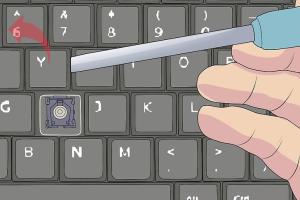Ultimate Guide to Repairing Dell Laptop Keyboard Keys: Step-by-Step Solutions

-
Quick Links:
- 1. Introduction
- 2. Understanding Common Keyboard Issues
- 3. Tools and Materials Needed
- 4. Step-by-Step Repair Guide
- 5. Preventive Maintenance Tips
- 6. Case Studies
- 7. Expert Insights
- 8. FAQs
1. Introduction
If you own a Dell laptop, chances are you may encounter issues with your keyboard over time. Keys can become unresponsive, sticky, or even fall off. In this guide, we will explore how to repair Dell laptop keyboard keys effectively, ensuring your laptop continues to serve you well. Whether you're facing issues with a single key or the entire keyboard, this comprehensive guide will provide you with the knowledge and tools needed to troubleshoot and resolve these issues.
2. Understanding Common Keyboard Issues
Before diving into repairs, it's essential to understand the common problems associated with Dell laptop keyboards. Here are some typical issues:
- Sticky Keys: Often caused by debris or spills.
- Unresponsive Keys: Can occur due to software issues or hardware malfunctions.
- Missing Keys: Keys may pop off due to wear or impact.
- Incorrect Key Mapping: Sometimes, keys may not register correctly due to software settings.
3. Tools and Materials Needed
To effectively repair your Dell laptop keyboard, gather the following tools and materials:
- Small Phillips screwdriver
- Plastic spudger or pry tool
- Compressed air canister
- Microfiber cloth
- Replacement keys or keycaps (if necessary)
- Isopropyl alcohol (for cleaning)
4. Step-by-Step Repair Guide
Now, let’s get into the details of repairing the keyboard keys on your Dell laptop. This guide will cover various scenarios, from cleaning to replacement.
4.1 Cleaning Your Keyboard
Sometimes, the issue with a keyboard can be solved with a good cleaning. Follow these steps:
- Turn off your laptop and unplug it.
- Use the compressed air canister to blow out any debris from between the keys.
- Dampen a microfiber cloth with isopropyl alcohol and gently wipe the surface of the keys.
4.2 Fixing Sticky Keys
If you have sticky keys, here’s how to resolve that:
- Remove the affected key using a plastic spudger. Be careful not to break the clips.
- Clean the area underneath the key with a cotton swab and isopropyl alcohol.
- Allow it to dry completely before reattaching the key.
4.3 Replacing Missing Keys
If a key is missing or broken, you can replace it:
- Purchase a replacement key compatible with your Dell laptop model.
- Align the key with the clips and press down until it clicks into place.
4.4 Troubleshooting Unresponsive Keys
If certain keys are unresponsive:
- Check for software issues. Restart your laptop and see if the problem persists.
- Update your keyboard drivers via Device Manager.
- If software updates don’t work, consider reseating the keyboard connection by disassembling the laptop.
5. Preventive Maintenance Tips
To avoid future issues with your Dell laptop keyboard, consider these preventive measures:
- Keep food and drinks away from your laptop.
- Regularly clean your keyboard using compressed air.
- Use a keyboard cover to protect against dust and spills.
6. Case Studies
Here are a couple of real-world case studies that highlight common keyboard issues faced by Dell laptop users:
Case Study 1: The Sticky Key Dilemma
A user reported that the ‘E’ key on their Dell laptop was sticky due to spilled soda. After following the cleaning steps outlined, they were able to resolve the issue without needing to replace the key.
Case Study 2: The Unresponsive Key Mystery
Another user faced unresponsive keys after a system update. By updating their drivers and restarting the laptop, the issue was resolved.
7. Expert Insights
Experts recommend regular maintenance of your keyboard to prevent buildup of debris and other issues. They emphasize the importance of using appropriate tools and methods when performing repairs to avoid causing further damage.
8. FAQs
1. How do I know if my keyboard needs to be replaced?
If multiple keys are unresponsive or if the keyboard is physically damaged, it may be time for a replacement.
2. Can I fix a laptop keyboard without professional help?
Yes, many keyboard issues can be resolved at home with the right tools and guidance.
3. What should I do if my keyboard keys keep popping off?
Ensure the clips are not broken and consider replacing the key if it continues to come off.
4. How often should I clean my keyboard?
It is advisable to clean your keyboard every few weeks, especially if you use it frequently.
5. Can I use water to clean my keyboard?
It’s best to avoid water. Use isopropyl alcohol instead, as it evaporates quickly and won’t damage electronics.
6. Are replacement keys expensive?
No, replacement keys are generally affordable and can be purchased online or through authorized dealers.
7. What tools do I need for keyboard repair?
You typically need a small screwdriver, a spudger, compressed air, and cleaning materials.
8. How do I prevent keyboard issues in the future?
Regular cleaning and using a keyboard cover can help minimize problems.
9. Can software issues affect my keyboard?
Yes, software glitches can cause keyboard malfunctions. Restarting or updating drivers often resolves these issues.
10. Is it safe to disassemble my laptop for keyboard repairs?
As long as you follow proper guidelines and are cautious, disassembling your laptop for repairs can be safe.
Random Reads